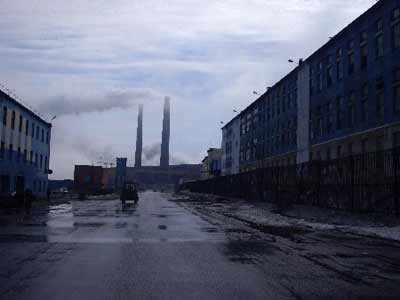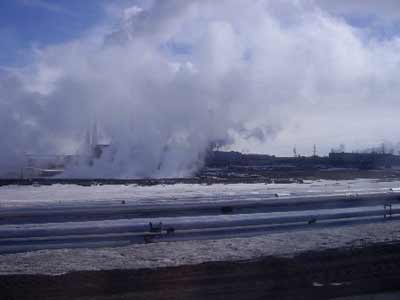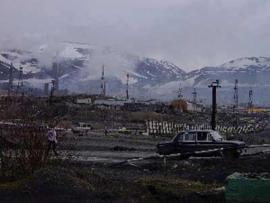Norilsk, Russia
- Potentially Affected People: 134,000
- Type of Pollutants: Air pollution - particulates, sulfur dioxide, heavy metals (nickel, copper, cobalt, lead, selenium), phenols, hydrogen sulfide.
- Source of Pollution: Major nickel and related metals mining and processing
The Problem
An industrial city founded in 1935 as a slave labor camp, the Siberian city of Norilsk, Russia is the northernmost major city of Russia and the second largest city (after Murmansk) above the Arctic Circle. Mining and smelting operations began in the 1930s and this city now contains the world's largest heavy metals smelting complex, where nearly 500 tons each of copper and nickel oxides and two million tons of sulphur dioxide are released annually into the air. The city has been accused of being one of the most polluted places in Russia, where the snow is black, the air tastes of sulfur and the life expectancy for factory workers is 10 years below the Russian average. A 1999 study found elevated copper and nickel concentrations in soils in as much as a 60 km radius of the city.
Norilsk Nickel, the firm responsible for the pollution, is one of Russia's leading producers of non-ferrous and platinum-group metals. It controls one-third of the world's nickel deposits and accounts for a substantial portion of the country's total production of nickel, cobalt, platinum, and palladium. It also ranks first among Russian industrial enterprises in terms of air pollution. The plants were constructed during the Soviet era, a period of non-existent environmental standards or controls.
Health Impacts
The local population is severely affected by the air quality where air samples exceed the maximum allowable concentrations for both copper and nickel. Children suffer from numerous respiratory diseases. Investigations evaluating the presence of ear, nose and throat diseases among schoolchildren revealed that children living near the copper plant were twice as likely to become ill than those living in further districts. Similarly, children living near the nickel plant were shown to become ill at a rate 1.5 times higher than children from further districts. Mortality from respiratory diseases is considerably higher than the average in Russia, accounting for 15.8% of all deaths among children. Premature births and late-term pregnancy complications are also frequent. Sulfur dioxide emissions contribute to chronic diseases of the lungs, respiratory tracts, and digestive systems - and can result in lung cancer.
Status of Clean-Up Activity
According to company reports, Norilsk Nickel has worked consistently to reduce emissions of major air pollutants. In 2006, the company reported investment of more than US $5m to maintain and overhaul its dust and gas recovery and removal systems. It asserts a commitment of nearly US $1.4m for its air pollution prevention plan. However, official statistics state that emissions remain extremely high.
Norilsk Nickel has been amenable to Blacksmith Institute's efforts to investigate the plant and facilities. Blacksmith representatives visited the site in July of 2007 and confirmed that, indeed, the company was making significant efforts to address the level of emissions. Norilsk Nickel stated their intention to move the nickel plant inside the city to a plant just outside. They also aspire to reduce the volume of sulphur dioxide emissions to 400 thousand tons by 2015 (which would result in normal atmospheric air) but admit that goal deadline is an extremely ambitious one.
Blacksmith staff also met with leading experts on environment and health while conducting this recent site assessment. These local experts confirmed extremely high levels of atmospheric contamination. They reported that although there have been some reductions in pollution levels, levels of SO2, HS, phenol, formaldehyde, and dust had increased; levels of nickel and copper had increased by 50%. Morbidity rates are stable and death rates are decreasing.
Their reports on children's health confirmed much higher rates of respiratory, digestive and nervous illnesses and more abortions and premature births than other cities in the region. Incidences of cancer (especially lung) have increased. Some estimates state that air pollution is responsible for 37% of children's morbidity rates and 21.6% of adult morbidity.
Resources
Norilsk Nickel. Company Report on Air Pollution Reduction Measures in 2006 and Plans for 2007.
S. M. Allen-Gil, J. Ford, B. K. Lasorsa, M. Monetti, et al. "Heavy metal contamination in the Taimyr Peninsula, Siberian Arctic". The Science of the Total Environment 301 (2003) 119-138.
J. M. Blais, K. E. Duff, T.E. Laing, J.P. Smol. "Regional contamination in lakes from the Noril.sk region in Siberia, Russia". Water Air Soil Pollut. (1999) 110 (3-4) 389-404.
O.N. Zubareva, L. N. Skripal.shchikova, N. V. Greshilova, and V. I. Kharuk. "Zoning of landscapes exposed to technogenic emissions from the Norilsk Mining and Smeltering works". Russian Journal of Ecology (2003) 34 (6) 375-380.
B. A. Revich. "Public health and ambient air pollution in Arctic and Subarctic cities of Russia". The Science of the Total Environment. (1995). 160/161 585-592.
Additional Photos
 |
Norilsk has the world's largest heavy metals smelting complex. It's operations are releasing 4 million tons of Cd, Cu, Pb, Ni, As, Se and Zn into the air annually. Photo Credit: Hans Wendel/Blacksmith Institute |
 |
Children in Norilsk are suffering from respiratory diseases, along with ear, nose and throat disesases. Photo Credit: Hans Wendel/Blacksmith Institute |




